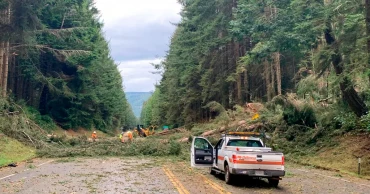California
4 dead and 10 injured in California shooting
A shooting at a family gathering in a Stockton banquet hall left four people dead and 10 others injured, officials said Saturday (November 29).
San Joaquin County sheriff’s spokesperson Heather Brent confirmed that both children and adults were among the victims and said early reports indicate the attack may have been targeted.
The suspected shooter remains at large, and authorities are appealing to the public for information. “If you know anything about this individual, contact authorities immediately. If you are the suspect, turn yourself in,” District Attorney Ron Freitas said.
Read more: Afghan national arrested after White House-area National Guard shooting
The incident occurred shortly before 6 p.m. at the hall, which shares a parking lot with other businesses. Stockton, located about 40 miles south of Sacramento, has a population of roughly 320,000.
Mayor Christina Fugazzi expressed grief over the tragedy, noting the heartbreak for families forced to watch their loved ones fight for survival in hospitals. Several victims were hospitalized, though officials have not yet released details on their conditions.
Read more: US suspends all asylum decisions following National Guard shooting
5 days ago
Thousands flee as wildfires devastate Los Angeles
Thousands of residents have fled as wildfires ravage areas around Los Angeles, destroying homes and overwhelming roads, reports AP.
Firefighters are battling intense winds that are propelling the flames, and several fires remain uncontained.One fire, which began Tuesday evening near a nature preserve in the foothills northeast of LA, spread so rapidly that staff at a senior living centre had to evacuate residents, some of whom were over 100 years old. They waited in parking lots under a red sky until they could be transported to safety.
Staying safe in a wildfire: What to pack and when to evacuate
Another fire, which started earlier, ravaged the Pacific Palisades, an upscale coastal area. As people fled, the roadways became gridlocked, forcing many to abandon their cars and escape on foot, some carrying bags and children. Emergency vehicles struggled to reach the area, and a bulldozer had to clear a path through the abandoned cars. Destruction along the Pacific Coast Highway was widespread.
A third fire broke out in Sylmar around 10:30 p.m., triggering evacuations. The fires were fanned by Santa Ana winds of up to 70 mph, with some areas experiencing gusts up to 100 mph. The Los Angeles Fire Department appealed for off-duty firefighters to assist, while high winds prevented aircraft from assisting with firefighting efforts. Governor Gavin Newsom reported that over 1,400 firefighting personnel were deployed, and the Federal Emergency Management Agency provided support.
California will soon require insurers to increase home coverage in wildfire-prone areas
Authorities haven't provided an estimate of the damage caused by the Pacific Palisades fire, but about 30,000 people were under evacuation orders, and 13,000 structures were at risk. Governor Newsom declared a state of emergency, and many homes in the area were destroyed. The fire spread through Temescal Canyon, a popular hiking area, and damaged parts of the Palisades Charter High School.
By evening, the flames had reached Malibu, where several people were treated for burn injuries, and a firefighter sustained a serious head injury. By early Wednesday, three fires were still raging, including one that had burned 1.6 square miles, another that had scorched 500 acres, and the largest, which had consumed 4.5 square miles. Power outages affected over 200,000 people in Los Angeles County.
The region's persistent dry conditions and strong winds, exacerbated by the Santa Anas, have contributed to the severity of the fires. Many areas have not received significant rain since May, heightening the risk of wildfires. The Pacific Palisades, located along the coast near Malibu, saw dramatic scenes of homes burning as residents fled. Actor James Woods shared footage of the flames near his home, and the Getty Villa reported some damage to its grounds.
Wildfire tears through Southern California community after burning dozens of homes
Amid the chaos, several events were cancelled, including movie premieres, and schools in the affected areas were temporarily relocated. The Getty Museum confirmed that its staff and collection remained safe despite the nearby fire.
10 months ago
Environmental groups sue over California support for polluting biofuels
Several environmental groups are suing California air regulators over their recent update of a contentious climate program, saying they failed to address the pollution impacts of biofuels.
The lawsuits target the low-carbon fuel standard, which requires California to reduce the environmental impact of transportation fuels by incentivizing producers to cut emissions. The California Air Resources Board voted last month to increase the state’s emission reduction targets, fund charging infrastructure for zero-emission vehicles, and phase out incentives for capturing methane emissions from dairy farms to turn into fuel.
California, which often leads the nation on climate policy, plans to achieve so-called carbon neutrality by 2045, meaning the state will remove as many carbon emissions from the atmosphere as it emits. The state has passed policies in recent years to phase out the sale of new fossil-fuel powered cars, trucks, trains and lawn mowers.
One of the lawsuits filed this week, by the nonprofit Communities for a Better Environment, accuses the board of failing to thoroughly analyze the climate impacts of burning biofuels derived from plants and animal waste. Another, filed by Food and Water Watch, Central Valley Defenders of Clean Air and Water, and the Animal Legal Defense Fund, focuses on the impact of pollution often impacting low-income and Latino communities from the capture of methane from cow manure to turn into fuel.
“People who live near refineries in California are harmed by the spiraling expansion of polluting biofuels,” but CARB failed to analyze the resulting harm to these communities, said a statement by Katherine Ramos, a program director at Communities for a Better Environment.
Data on animal movements help Hungarian researchers create a swarm of autonomous drones
Environmentalists say the LCFS program has stimulated the production of polluting biofuels, competing with food production and contributing to deforestation. They want California to focus more on expanding the charging infrastructure for electric vehicles.
The agency declined to comment on the lawsuits but said the program plays an important role in combating climate change and improving air quality.
“The amendments channel global, national and local private sector investment towards increasing cleaner fuel and transportation options for consumers, accelerating the deployment of zero-emission infrastructure, and keeping the state on track to meet legislatively mandated air quality and climate targets,” Dave Clegern, a spokesperson for the board, said in an email.
11 months ago
Powerful Hurricane Hilary heads for Mexico's Baja. Rare tropical storm watch issued for California
Hurricane Hilary churned off Mexico's Pacific coast Friday as a powerful Category 4 storm threatening to unleash torrential rains on the mudslide-prone border city of Tijuana before heading into Southern California as the first tropical storm there in 84 years.
Forecasters warned the storm could cause extreme flooding, mudslides and even tornadoes across the region.
Hilary grew rapidly in strength early Friday before losing some steam, with its maximum sustained winds clocked at 130 mph (215 kph) in the evening, after falling from 145 mph (230 kph). Nevertheless, it was forecast to still be a hurricane when approaching Mexico’s Baja California peninsula on Saturday night and a tropical storm when approaching Southern California on Sunday.
Hurricane Ian: Florida’s death toll climbs to 27
Hilary was already disrupting life.
Major League Baseball rescheduled three Sunday games in Southern California, moving them to Saturday as part of split-doubleheaders. The National Park Service closed Joshua Tree National Park and Mojave National Preserve to keep people from becoming stranded amid flooding. Cities across the region, including in Arizona, were offering sandbags to safeguard properties against floodwaters.
No tropical storm has made landfall in Southern California since Sept. 25, 1939, according to the National Weather Service. The watch was posted for a wide swath of Southern California from the coast to interior mountains and deserts. The U.S. National Hurricane Center warned of potential threats to life and property.
Hurricane Bonnie weakens, heads out into Pacific
The latest forecast pointed to Hilary making landfall along a sparsely populated area of the Baja peninsula Sunday, about 200 miles (330 kilometers) south of the Pacific port city of Ensenada.
As it moves north, it could bring heavy rains to Tijuana. Mayor Montserrat Caballero Ramirez said the city was tracking the storm closely and clearing out storm drains.
Pamela could be hurricane again as it makes Mexico landfall
The sprawling border metropolis of 1.9 million people is particularly at risk of landslides and flooding, in part because of its hilly terrain. Shacks are perched on cliffs with little vegetation to hold soil in place. In addition, dozens of people live under tarps on the streets and in canals in flood zones, including migrants who arrive daily from various parts of the world.
The city was setting up four shelters in high-risk zones and warning residents in risky zones, Caballero Ramirez said.
“We are a vulnerable city being on one of the most visited borders in the world and because of our landscape," she said.
Mexico issued a tropical storm watch for parts of mainland Mexico and put 18,000 soldiers on alert.
On Friday evening, Hilary was centered about 310 miles (495 kilometers) south-southwest of Cabo San Lucas, near the southern tip of the Baja peninsula. It was moving northwest at 12 mph (19 kph) and was expected to turn more toward the north.
Some Cabo San Lucas schools were being prepared as temporary shelters, said Flora Aguilar, a city official.
In La Paz, the picturesque capital of Baja California Sur state on the Sea of Cortez, police patrolled closed beaches to keep swimmers out of the whipped-up surf. Schools were shut down in five municipalities.
It was increasingly likely that Hilary would reach California early Monday while still at tropical storm strength, though widespread rain was expected to begin as early as Saturday, the National Weather Service’s San Diego office said.
Hurricane officials said the storm could bring heavy rainfall to the southwestern United States, dumping 3 to 6 inches (8-15 centimeters) in places, with isolated amounts of up to 10 inches (25 centimeters), in portions of southern California and southern Nevada.
“Two to three inches of rainfall in Southern California is unheard of” for this time of year, said Kristen Corbosiero, a University of Albany atmospheric scientist who specializes in Pacific hurricanes. “That’s a whole summer and fall amount of rain coming in probably six to 12 hours.”
The region could face once-in-a-century rains and there is a good chance Nevada will break its all-time rainfall record, said meteorologist Jeff Masters of Yale Climate Connections and a former government in-flight hurricane meteorologist.
President Joe Biden said the Federal Emergency Management Agency had pre-positioned staff and supplies in the region.
“I urge everyone, everyone in the path of this storm, to take precautions and listen to the guidance of state and local officials,” Biden told reporters Friday at Camp David, where he is meeting with the leaders of Japan and South Korea.
Deputies with the Los Angeles Sheriff's Department announced warnings over public address systems and urged homeless people living in riverbeds and other potentially dangerous areas to move into shelters before the storm hits.
Authorities in the city were also helping arrange food, cots and shelters for people who needed them, officials said at an afternoon news conference.
Janice Hahn, chair of the Los Angeles County Board of Supervisors, said planning had been underway for several days, which included evacuation plans for the tourist destination of Santa Catalina Island, off the coast.
“I don’t think any of us — I know me particularly — never thought I’d be standing here talking about a hurricane or a tropical storm,” Hahn said.
Officials in Southern California were also re-enforcing sand berms, built to protect low-lying coastal communities against winter surf, like in Huntington Beach, which dubs itself as “Surf City USA."
In nearby Newport Beach, Tanner Atkinson waited in a line of vehicles for free sandbags at a city distribution point.
“I mean a lot of people here are excited because the waves are gonna get pretty heavy," Atkinson said. "But I mean, it’s gonna be some rain, so usually there’s some flooding and the landslides and things like that.”
SpaceX delayed the launch of a satellite-carrying rocket from a base on California’s central coast until at least Monday. The company said conditions in the Pacific could make it difficult for a ship to recover the rocket booster.
Storms don’t usually hit Southern California because prevailing winds usually push them either due west into open ocean or northeastward into Mexico and other parts of the U.S. Southwest, according to experts.
“Almost all of them just go out to sea. That’s why we never hear about them,” said Kerry Emanuel, a hurricane professor at Massachusetts Institute of Technology.
That's unlikely to happen with Hilary mostly because of a high pressure heat dome that is expected to bring triple digit heat indices in the Midwest and block the eastern turn, Masters said.
2 years ago
Another atmospheric river pounds California, 27K to evacuate
The latest powerful atmospheric river to drench California put nearly 27,000 people under evacuation orders Tuesday due to flooding and landslide risks. On the central coast, workers hauled truckloads of rocks to plug a broken river levee amid steady rain and wind.
Damaging winds with gusts topping 70 mph (113 kph) blew out windows, and there were numerous reports of falling trees. Power outages hit more than 330,000 utility customers in northern and central areas, according to poweroutage.us, which tracks outages nationwide.
Crews raced to stabilize the Pajaro River's ruptured levee Tuesday, placing rocks and boulders to finish filling the gap that opened late Friday, about 70 miles (110 kilometers) south of San Francisco. Workers will then raise that portion's elevation to match the rest of the levee over the next few weeks to make it impermeable, officials said.
Tuesday's storm initially spread light to moderate rain over the state's north and center. But the National Weather Service said the storm was moving faster than expected and that most of the precipitation would shift southward.
Also Read: Snow, rain slam California as Michigan suffers without power
“Even a small amount of rain could potentially have larger impacts,” Shaunna Murray of the Monterey County Water Resources Agency said Tuesday during a news conference.
Powerful winds damaged windows in a San Francisco high-rise, causing glass to rain down and forcing evacuations from the building in the financial district. No injuries were immediately reported. A gust of 74 mph (119 kph) was recorded at the city's airport, the weather service said.
So far this winter, California has been battered by 10 previous atmospheric rivers — long plumes of moisture from the Pacific Ocean — as well as powerful storms fueled by arctic air that produced blizzard conditions. On the East Coast, the start of a winter storm with heavy, wet snow caused a plane to slide off a runway and led to hundreds of school closings, canceled flights and thousands of power outages Tuesday.
Along the Southern California coast, evacuation orders began at 8 a.m. in Santa Barbara County for several areas burned by wildfires in recent years, creating increased risk of flash floods and debris flows.
The storm caused emergency declarations for 40 counties.
Also Read: Police say 3 dead, 4 hurt in latest California shooting
In addition to evacuation orders, more than 71,600 people were under evacuation warnings and 546 people were in shelters by Tuesday morning, said Brian Ferguson, spokesperson for the California Office of Emergency Services. Updated figures were not immediately available.
More flooding was expected on the central coast, where the Pajaro River swelled with runoff from last week's atmospheric river. Authorities had not received reports of any deaths or missing persons related to the storm as of Monday.
The levee breach grew to at least 400 feet (120 meters) since the failure late Friday, officials said. A roughly 20-foot (6.10-meter) gap remained Tuesday afternoon.
Pajaro, an unincorporated community known for its strawberry crops, was largely flooded. More than 8,500 people were told to evacuate, and nearly 250 people have been rescued by first responders since Friday.
Some residents of the largely Latino farmworker community stayed. One shelter was already full by midday Tuesday, and officials were forced to open two more to accommodate the evacuees.
“We live seven houses away from the river and the water level was six feet high, seven probably,” said evacuee Andres Garcia. “So we probably lost everything.”
A second 100-foot (30-meter) breach in the levee opened closer to the Pacific coast, providing a “relief valve” for floodwaters to recede near the mouth of the river, officials said at a news conference Monday.
Built in the late 1940s to provide flood protection, the levee was a known risk for decades and had several breaches in the 1990s. Emergency repairs to a section of the berm were undertaken in January. A $400 million rebuild is set to begin in the next few years.
“We had so many years of drought and they could’ve fixed the levee way back and they didn’t," said Garcia, the Pajaro evacuee. "This is the second time it happened. Back in 1995, same thing. We lost everything.”
The river separates Santa Cruz and Monterey counties. Highway 1, a main link between the two counties, was closed along with several other roads.
2 years ago
Snow, rain slam California as Michigan suffers without power
Heavy snow and rain pounded California and other parts of the West on Friday in the nation's latest winter storm, while tens of thousands of people in Michigan suffered in freezing temperatures days after one of the worst ice storms in decades caused widespread power outages.
The winter storms have blacked out nearly 1 million homes and businesses from coast to coast, closed major roads, caused pileups on highways and snarled air travel. More than 1,200 flights were canceled and more than 17,000 were delayed Friday across the U.S., according to FlightAware.com.
The National Weather Service warned of a “cold and dangerous winter storm” that would last through Saturday in California. Blizzard warnings were posted in the Sierra Nevada and Southern California mountain ranges, where as much as 5 feet (1.5 meters) of snow was expected. Temperatures could drop far below normal in the region, posing a special risk to homeless people.
“Simply put, this will be a historic event for the amount of snow over the higher peaks and lower elevation snow,” according to the regional weather office.
Interstate 5, the West Coast’s major north-south highway, was closed south of the Oregon border as snow fell to the floor of the Sacramento Valley and in a high mountain pass north of Los Angeles, where blizzard warnings were in effect. Avalanche warnings were posted in some areas, and flash flood warnings were issued for Los Angeles and nearby coastal areas until Friday night.
In Michigan, hundreds of thousands of people remained without power Friday after a storm earlier this week coated power lines, utility poles and branches with ice as thick as three-quarters of an inch. Gov. Gretchen Whitmer called Friday for more accountability on restoration efforts by the state’s two largest utilities.
Also read: Police say 3 dead, 4 hurt in latest California shooting
Annemarie Rogers had been without power for a day and a half in Grosse Pointe Farms, Michigan. She sent two kids to stay with relatives and put extra blankets on the bed to try to keep warm.
“It’s kind of miserable,” she said. “We do have a gas fireplace that’s keeping us warm in one room. There’s some heat generating from the furnace, but with no electricity to the blower it’s not circulating well."
At one point, more than 820,000 customers in Michigan were in the dark. By Friday, that was down to under 600,000, most in the state's populous southeastern corner around Detroit. But promises of power restoration by Sunday, when low temperatures were expected to climb back above zero (minus 18 Celsius), were of little consolation.
“That’s four days without power in such weather," said Apurva Gokhale, of Walled Lake, Michigan. "It’s unthinkable.”
Tom Rankin said he and his wife were unable to reach his 100-year-old mother-in-law Friday morning by phone. The couple drove to her home in Bloomfield Township, Michigan, to find her in bed “with a whole lot of blankets,” Rankin said, adding they helped her to their car, planning to ride out the outage at another relative’s home.
“We’ve not had an ice storm in the last 50 years that has impacted our infrastructure like this,” said Trevor Lauer, president of Detroit-based DTE Electric.
At least three people have died in the storms. A Michigan firefighter died Wednesday after coming in contact with a downed power line, while in Rochester, Minnesota, a pedestrian died after being hit by a city-operated snowplow. Authorities in Portland, Oregon said a person died of hyperthermia.
Much of Portland was shut down with icy roads not expected to thaw until Saturday after the city’s second-heaviest snowfall on record this week — nearly 11 inches.
Tim Varner sat huddled with blankets in a Portland storefront doorway that shielded him from some of the wind, ice and snow. Local officials opened six overnight shelters but the 57-year-old, who has been homeless for two decades, said it was too hard to push a shopping cart containing his belongings to get to one.
“It’s impossible,” he said. “The snow gets built up on the wheels of your cart, and then you find slippery spots and can’t get no traction. So you’re stuck.”
Not all were dismayed by the winter weather. In the San Francisco Bay Area, hundreds of people drove up to 2,500-foot (760-meter) Mount Tamalpais to play in the snow — a rarity in the area.
San Francisco resident Shankar Krishnan woke up at 4 a.m. and headed out hoping to see snow for the first time in a long time.
“It feels awesome. It’s like the trees are all frosty,. There’s snow on the ground. There’s snow coming down from the sky," Krishnan said. "It’s beautiful out here.”
In Southern California, authorities warned that rainfall could cause debris flow in some areas burned by wildfires in recent years. In the flash flood warning area, between three and six inches (eight and 15 centimeters) of rain had fallen by Friday afternoon with another two to four inches (five and 10 centimeters) expected.
Evacuation warnings were issued in Ventura County for four areas considered unstable after being hit hard by storms last month. To the north, snow piled up across Santa Cruz County as roads closed and motorists were forced to abandon their cars.
Parts of Interstate 80 in California and Wyoming closed, including about a 70-mile (112-kilometer) stretch over the top of the Sierra Nevada linking California and Nevada. Some schools in Nevada and northern Arizona were closed, and a Major League Soccer season-opening game in Southern California was postponed.
The storm has added to major precipitation from December and January “atmospheric rivers” that improved California’s drought outlook, but authorities who allocate water to farms, cities and industries remain cautious because of a recent history of abrupt changes in hydrologic conditions.
The weather service said temperatures could drop far below normal in the region, posing a special risk to homeless people.
2 years ago
Baby, teen mom among 6 killed in shooting at California home
Six people — including a 17-year-old mother and her 6-month-old baby — were killed in a shooting early Monday at a home in central California, and authorities are searching for at least two suspects, sheriff’s officials said.
Deputies responded around 3:30 a.m. to reports of multiple shots fired at the residence in unincorporated Goshen, just east of Visalia, the Tulare County Sheriff’s Office said.
“Actually the report was that an active shooter was in the area because of the number of shots that were being fired,” Sheriff Mike Boudreaux told reporters.
Deputies found two victims dead in the street and a third person fatally shot in the doorway of the residence, Boudreaux said.
Three more victims were found inside the home, including a man who was still alive but later died at a hospital, he said.
The sheriff said investigators are searching for at least two suspects. They believe there is a gang connection to the killings. The sheriff’s office conducted a narcotics-related search warrant at the residence last week, Boudreaux said.
“We also believe this was not a random act of violence. We believe this was a targeted family,” he said.
Goshen is a semi-rural community of about 3,000 residents 35 miles (56 kilometres) southeast of Fresno in the agricultural San Joaquin Valley.
Read more: 9 killed in Walmart shooting in Virginia
2 years ago
Southern California sheriff's deputy fatally shot east of LA
A Southern California sheriff's deputy was shot and killed Friday, just two weeks after another deputy in the department was slain in the line of duty.
The suspect is in custody, authorities said.
Riverside County Sheriff's Deputy Darnell Calhoun was fatally shot Friday afternoon in the city of Lake Elsinore, authorities said on Twitter. He was taken to the hospital in serious condition.
Few details were immediately available, including the suspect's identity and what prompted the shooting. It was not clear if the suspect also was injured. The sheriff's office plans to hold a news conference Friday night.
Lake Elsinore is about 55 miles (88 kilometers) southeast of downtown Los Angeles.
Friday's shooting comes as the sheriff's department is reeling from the death of Deputy Isaiah Cordero. The 32-year-old was fatally shot Dec. 29 during a traffic stop in the city of Jurupa Valley, east of Los Angeles.
Read more: Shooting near Chicago school leaves 2 pupils dead and 2 injured
Cordero had pulled over a pickup truck and the driver, 44-year-old William Shae McKay, shot the deputy as he approached the vehicle. Law enforcement pursued McKay in a manhunt that included a chase along freeways in two counties, authorities said.
McKay was killed during a shootout with deputies after the truck crashed.
Riverside County Sheriff Chad Bianco and Cordero's family have called for the resignation of a Southern California judge who allowed McKay's release from custody on bail despite his lengthy criminal history.
The sheriff said McKay was convicted of a “third strike” offense in 2021 that should have put him in state prison for 25 years to life, but the judge lowered his bail, allowing his release, and later released him following an arrest for failing to appear at his sentencing.
Read more: Killing of Bangladeshi-American in US: Human chain in front of MoFA demands justice
2 years ago
'Bomb cyclone' brings damaging winds, drenches California
Hurricane-force winds, surging surf and heavy rains from a powerful “atmospheric river” pounded California on Thursday, knocking out power to tens of thousands, causing flooding, and contributing to the deaths of at least two people, including a toddler whose home was crushed by a falling tree.
Raging seas damaged two historic piers, rock and mudslides closed down highways, and deep snow piled up at ski resorts in the latest in a series of atmospheric rivers — long plumes of moisture stretching far over the Pacific — to reach the drought-stricken state. The “Pineapple Express” storm originated near Hawaii and was pulled toward the West Coast by a rotating area of rapidly falling air pressure known as a “bomb cyclone.”
Even as rains were expected to let up and some evacuation orders lifted Thursday, crews were assessing damage, trying to restore power and beginning the cleanup while bracing for more wet and wild weather this weekend that could be particularly troublesome for communities along swollen rivers.
The blustery tempest that came ashore Wednesday knocked out power to more than 180,000 homes and businesses, according to poweroutage.us.
In Sonoma County, Aeon Tocchini, a 2-year-old boy, was killed when a redwood tree crumpled a section of his family's mobile home where he had been sitting on a sofa, authorities said. His father and neighbors freed the boy — nicknamed “Goldie” because of his light hair and sunny personality — but he couldn't be revived.
“He was the happiest child, always smiling and encouraging people,” his teary-eyed grandmother Aileen Tocchini said outside the damaged Occidental home where a red tricycle and yellow dump truck were buried under broken branches. "He was a love, an angel.”
Read more: Western NY death toll rises to 28 from cold, storm chaos
In Fairfield, a 19-year-old woman died after her vehicle hydroplaned on a flooded road and hit a utility pole, police said on Facebook.
The seaside village of Capitola in Santa Cruz County about 60 miles (100 kilometers) south of San Francisco suffered possibly the worst damage as waves that were forecast to top 25 feet (7.6 meters) crashed into homes and restaurants at the mouth of Soquel Creek and knocked out a section of its historic wooden pier.
Surf shattered the windows at Zelda’s on the Beach, tossing furniture around inside the eatery. The Wharf House restaurant, at the end of the Capitola Wharf, was cut off from the mainland after a midspan of the wooden structure collapsed.
Wharf House owner Willie Case said he had a “great degree of sadness” as he looked at the damage from a cliff above the village and lamented this his employees would be out of work until the pier is repaired. He noted that in 1982, the former restaurant at that site fell into the sea. He anticipates more damage as new storms roll in.
“I don’t think the party’s over yet,” he said.
Hurricane-strength gusts as high as 101 mph (162 kph) toppled trees onto buildings and roads, knocked out power lines and blew down the roof on a gas station in South San Francisco.
National Weather Service meteorologist Warren Blier said the wind speed recorded on a Marin County hilltop was among the highest he could recall in a 25-year career.
A large eucalyptus tree in Oakland crashed through the roof of Victoria James' apartment as she was preparing for dinner Wednesday. She and her children ran into the hallway, initially thinking it was an earthquake, and braced for an aftershock.
As water began pouring into their home, the family fled with only clothes on their backs – some of the children without shoes.
“There’s big holes in the ceiling. In my bedroom, the living room and the kitchen for sure,” she said from her car. “Everything’s damaged.”
A California Highway Patrol officer responding to a crash in San Jose was struck and injured by a tree on Highway 17, Officer Ross Lee said. The officer was expected to survive.
In Southern California, a helicopter crew plucked a man clinging to bamboo branches from an island in the Ventura River, Ventura County Fire Department spokesperson Andy VanSciver said.
Read more: Millions in US hunker down from frigid, deadly monster storm
The blustery winds and incessant rain were especially taxing for the homeless population in California, where 100,000 people live on the streets.
Glenn Scott, 59, who has arthritis in both knees and feet and needs a cane to walk, sought refuge on a bench outside the main San Francisco public library with a small group of other homeless people.
“I just have to do whatever I’ve gotta do and go wherever I can to get peace of mind,” Scott said.
California Gov. Gavin Newsom declared a state of emergency to allow for a quick response and to aid in cleanup from another powerful storm that hit just days earlier.
In the coastal community of Aptos, about dozen people were stuck at their homes because flooding, downed trees and debris blocked the road out, said Paul Karz, an employee at Seacliff State Beach. Violent waters had tossed picnic tables against a cliff, wiped out much of the beach boardwalk, damaged its wooden wharf and left only a “skeleton” of its sea wall.
Sonoma County authorities issued an evacuation warning for a string of towns along the Russian River, where greater flooding was expected by Sunday.
Sections of Highway 101 in Northern California were closed due to downed trees, while rockfall had shuttered several sections of the coastal Highway 1, including in the scenic Big Sur area.
As much as 2 feet (61 centimeters) of snow fell on Mammoth Mountain over 24 hours and more was expected, delivering another bonus to Sierra Nevada ski areas.
The storm came days after a New Year’s Eve downpour led to evacuations in Northern California, where at least four people died in flooding.
Atmospheric rivers, named by researchers in the 1990s, occur globally but are especially significant on the U.S. West Coast, where they create 30% to 50% of annual precipitation, according to the National Oceanic and Atmospheric Administration.
The storms won’t be enough to officially end the state’s ongoing drought, now entering its fourth year, but they have helped. Not including the latest deluge, recent storms moved parts of the state out of the “exceptional drought” category in the U.S. Drought Monitor. Most of the state, though, remains in the extreme or severe drought categories.
2 years ago
Evacuations ordered as California braces for rain, floods
As a huge storm approached California on Wednesday, officials began ordering evacuations in a high-risk coastal area where mudslides killed 23 people in 2018, while residents elsewhere in the state scrambled to find sandbags, and braced themselves for flooding and power outages.
California Gov. Gavin Newsom declared a state of emergency to allow for a quick response and to aid in cleanup from another powerful storm just days earlier. Dozens of flights were cancelled at the San Francisco International Airport, and South San Francisco schools preemptively cancelled Thursday classes. As the storm intensified, state officials warned residents in Northern California to stay off the roads.
The first evacuations were ordered for those living in the burn scar areas of three recent wildfires in Santa Barbara County, where heavy rain is expected overnight, and could cause widespread flooding and unleash debris flows in several areas. Among them is the tony town of Montecito, home to many celebrities, including Oprah Winfrey and Prince Harry and his wife, Meghan Markle.
“We anticipate that this may be one of the most challenging and impactful series of storms to touch down in California in the last five years,” said Nancy Ward, the new director of the California Governor’s Office of Emergency Services.
Officials asked drivers to stay off the roads unless absolutely necessary — and to stay informed by signing up for updates from emergency officials about downed trees and power lines, and flooding. In Northern California, a 25-mile (40-kilometer) stretch of Highway 101 was closed between the towns of Trinidad and Orick due to several downed trees.
Before the storm arrives late Wednesday, Santa Barbara County Sheriff Bill Brown said people should evacuate the areas impacted by the Alisal Fire last year, the Cave Fire in 2019 and the devastating Thomas Fire in 2017, one of the largest in California history.
On Jan. 9, 2018, massive torrents carrying huge boulders, mud and debris roared down coastal mountains, and through the town of Montecito to the shoreline, killing 23 people and destroying more than 100 homes. Among those killed were two children whose bodies were never found.
Read more: 48 deaths reported in US from massive storm
Montecito Fire Department Chief Kevin Taylor said Wednesday that homes near waterways are at the greatest risk.
“What we’re talking about here is a lot of water coming off the top of the hills, coming down into the creeks and streams and as it comes down, it gains momentum and that’s what the initial danger is,” he said.
Storms in the last 30 days have produced between 8 to 13 inches of rain, soaking coastal hills in Santa Barbara County. The current storm is projected to drop up to 10 inches of rain in the area, Taylor said.
“This cumulative rain ... is what causes our risk,” he said.
The storm, set to be in full force in Northern California by Wednesday evening, is one of three so-called atmospheric river storms in the last week to reach the drought-stricken state. Because the states' major reservoirs are at a record low from a dry three-year period, they have plenty of room to fill with more water from the impending storm, officials said.
Still, trees are already stressed from years of limited rain. Now that the grounds are suddenly saturated and winds are heavy, trees are more likely to fall. That could cause widespread power outages or create flood hazards, said Karla Nemeth, director of the state’s Department of Water Resources.
“We are in the middle of a flood emergency and also in the middle of a drought emergency,” she said during an emergency briefing.
The storm comes days after a New Year’s Eve downpour led to the evacuations of people in rural Northern California communities and the rescue of several motorists from flooded roads. A few levees south of Sacramento were damaged.
In the San Francisco Bay Area, 8,500 sandbags distributed by officials weren’t enough to reach demand Wednesday as forecasters warned of imminent flooding. The South San Francisco Unified School District announced classes for its 8,000 students would be canceled Thursday “out of an abundance of caution.”
Heavy downpours accompanied by winds with gusts of up to 60 mph (96 kph) were expected later Wednesday and through Thursday, making driving conditions difficult, the National Weather Service said. In Southern California, the storm was expected to peak in intensity overnight, with Santa Barbara and Ventura counties likely to see the most rain, forecasters said.
Read more: Wild winter storm envelops US, snarling Christmas travel
Aaron Johnson, Pacific Gas & Electric regional vice president for the Bay Area, said the company has more than 3,000 employees working in crews of three to five people to assess damages to their equipment and restore power as soon as possible.
Robert O’Neill, an insurance broker who lives and works just south of San Francisco, said he lined up to get sandbags for his garage and for a co-worker’s home to prepare for the storm.
As president of Town & Country Insurance Services, he gave employees the option of working from home Wednesday, which many did, he said. He plans to leave the office early and head home where he has go-bags packed with clothes, medicine, electronic chargers and important papers. He has sleeping bags and three days’ worth of water, nuts and protein bars.
“We’re in a big city, so we wouldn’t be too stranded too long, but you never know,” he said.
The storms in California still aren’t enough to officially end the drought, now entering its fourth year. The U.S. Drought Monitor showed that most of the state is in severe to extreme drought.
Elsewhere, in the Midwest, ice and heavy snow has taken a toll this week, closing down schools in Minnesota and western Wisconsin — and causing a jet to go off an icy taxiway after landing in a snowstorm in Minneapolis. No passengers were injured, Delta airlines said.
To the south, a possible tornado damaged homes, downed trees and flipped a vehicle on its side in Montgomery, Alabama, early Wednesday. Christina Thornton, director of the Montgomery Emergency Management Agency, said radar indicated a possible, but unconfirmed, tornado. The storm had extremely high winds and moved through the area before dawn, she said.
Staff from the National Weather Service's Chicago office planned to survey storm damage on Wednesday following at least six tornados, the largest number of rare January tornadoes recorded in the state since 1989.
2 years ago



















